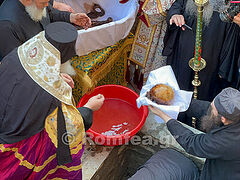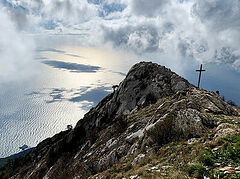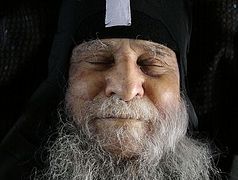 Elder Joseph of Vatopedi It was early September 2007. These were the last days of my pilgrimage to Mt. Athos. For almost a month I had been visiting the monasteries around the Holy Mountain, along with some sketes and cells in search of someone who could set straighten out my mind. There were plenty of problems with my brains: rampant anti-globalism, grievances against our Church hierarchy (reasonable), a categorical desire (even a demand!) with the help of the elders to “look out the window” and find out what awaited us in the near future, whether the end of the world was near, and so on in the same spirit. It wasn’t an easy thing for the Athonites to talk with me...
Elder Joseph of Vatopedi It was early September 2007. These were the last days of my pilgrimage to Mt. Athos. For almost a month I had been visiting the monasteries around the Holy Mountain, along with some sketes and cells in search of someone who could set straighten out my mind. There were plenty of problems with my brains: rampant anti-globalism, grievances against our Church hierarchy (reasonable), a categorical desire (even a demand!) with the help of the elders to “look out the window” and find out what awaited us in the near future, whether the end of the world was near, and so on in the same spirit. It wasn’t an easy thing for the Athonites to talk with me...
My Schengen visa was expiring very soon, a return airplane ticket was already purchased, and I had to think about punctually appeared before the menacing eyes of a customs officer at the Thessaloniki airport. The fine for overstaying was 2000 euros. In addition, I was warned about a possible storm at sea, which meant that the ferry service from Daphne to Ouranoupoli would stop and I would lose another day. In short, I was pressed for time.
In Ulyanovsk, before leaving for Mt. Athos, I had compiled a list of the most famous elders whom I desperately needed to visit. And now, after a month, there were checkmarks before all the names, except for the world-famous elder, Schemamonk Joseph of Vatopedi. His spiritual relationship with Elder Joseph the Hesychast (†1959) made him particularly interesting to me. And the fact that he was the spiritual father of the numerous brethren of Vatopedi Monastery spoke volumes.
But where could I find him? He was already old, didn’t go to services at the Vatopedi Monastery’s main cathedral every day, didn’t even live at the monastery, and the Greeks I asked regarding his whereabouts would immediately run away. In a word, they took full care of the elder.
So, during my first two trips to Vatopedi Monastery, I methodically, square by square, narrowed the circle of search in the sketes adjacent to the monastery. And now I was lucky! In a two-storied house for workers beside the arsana (port) someone suggested to me where the elder’s cell might be. But then my time was running out and I had to go further, so I postponed my visit to the elder. However, I remembered the proposed spot.
***
A few words should be said about Vatopedi Monastery. In the hierarchy of the twenty Athonite monasteries it is second only to the Great Lavra of St. Athanasius of Mt. Athos. What catches the eye there is the large number of its monks, especially if you go around the whole of Mt. Athos and have something to compare it with. But most of them are rather dark-skinned. These are Greek Cypriots, compatriots of Elder Joseph who too came to Mt. Athos from Cyprus.
It was here, from Her icon hanging above the entrance to the monastery, that the Mother of God in 422 A.D. first communicated through the Byzantine Princess Galla Placidia (daughter of Emperor Theodosius the Great) Her will for women never to appear on Mt. Athos. The long list of relics kept at the monastery includes the reliquary with the Cincture of the Most Holy Theotokos, the original Icons of the Theotokos Pantonassa and Comfort (Consolation), the skulls of Sts. John Chrysostom and Gregory the Theologian, and many, many other great relics of the Orthodox world!
***
And here I am for the third time on my journey heading from Karyes to the famous Vatopedi Monastery. I travelled on foot, with a huge backpack on my back.
The main north-south road runs on the peninsula strictly along the crest of the mountain range. From certain spots, you can see the Aegean Sea in the east and the Singitic Gulf in the west.
Soon a passing pick-up truck stopped. I threw up my hands guiltily, shouting in Greek, “Sorry, I don’t have any euros.” The monks smiled and waved their hands. I jumped into the back of the truck without even taking off my backpack. “What kind people they are!” I thought, lying on the floor and watching the tops of tall trees floating over the road.
At a fork in the road the car stopped, the monks showed me the direction to Vatopedi Monastery, and turned left, to Kastamonitou Monastery. After walking a couple of miles down the slope, I heard the noise of another car behind me. The driver stopped. Angelos—that was the name of my driver—was a Pontic Greek. He grew up in the USSR on the Black Sea and had recently moved with his family to Greece. They live opposite Mt. Athos—on Halkidiki, and here he was simply “on duty”, working as a driver in the Russian Xilourgou Skete. Having learned all this, I had a good feeling, thinking, “There is a car, the driver is friendly, and he knows both Russian and Greek, which means he can be my interpreter. What else do I need?”
On that Sunday evening Angelos was returning to the Xilourgou Skete from the port of Daphne’s after taking the skete’s abbot, Hieromonk Nikolai (Generalov), to a boat. Mother Georgia (Shchukina), the then abbess of Gorny Convent in Jerusalem, had phoned Fr. Nikolai either from Thessaloniki or Ouranoupoli. Arriving on a pilgrimage to Greece, she wanted to see her old spiritual friend, because Fr. Nikolai had once served in the Russian Gorny Convent.
Happy to meet a compatriot, Angelos agreed to give me a lift to Vatopedi Monastery for free. But when he learned that I was interested in Elder Joseph, he got enthusiastic. “I’ve heard a lot about him. And I’m ashamed to say that I’ve been working here for so many years, but I’ve never been to Fr. Joseph. Let’s go to him together.” Well, what could I say? Joy shone in my eyes for a long time!
Angelos first drove into the monastery. But everyone avoided our straightforward questions about the elder. Finally a Greek told us the way, but advised us to come to the elder the next day, after ten in the morning. Excited, we decided to track down the location of the skete before leaving. Having circled a little from the western side of Vatopedi Monastery, we found the skete, but didn’t bother the elder and his cell-attendant. By the way, the location of the skete coincided with my information received from the above-mentioned worker from the port.
“Come on, Sergei! I’ll take you to the Xilourgou Skete,” Angelos told me. “you’ll have a meal and stay overnight. In the morning we’ll go together to Fr. Joseph. If you’re tired, we have good wine.” “I don’t drink alcohol,” I replied resolutely. Angelos chuckled incredulously, “That’s the first time I’ve seen a Russian who doesn’t drink!”
Holy warriors of Princess Olga
The Xilourgou Skete is a tiny oasis of civilization in a dense forest. It translates from Greek roughly as “cutting area.” Officially it belongs to the Russian St. Panteleimon Monastery. This is one of the few surviving fragments of the once developed network of Russian sketes on Mt. Athos.
***
Despite its remoteness and smallness, the Xilourgou Skete played an outstanding role in the history of Russian monasticism on Mt. Athos. As I was told by Hierodeacon Vladimir from the skete that it was here that Russian Christians began to settle on Mt. Athos. Their first wave included warriors of Equal-to-the-Apostles Princess Olga!
When the grandmother of the future Prince Vladimir, Princess Olga, went on a pilgrimage to Constantinople in 954, she was accompanied by a large flotilla of Russian warships. After living in the capital of Byzantium for three or four years, in 957 the princess was baptized with the name Helen, and presumably many of the Russian soldiers who accompanied her converted to Christianity as well. In Constantinople they learned from Greeks not only about Christianity, but also about monastic life and Holy Mount Athos as the garden of the Most Holy Theotokos. No wonder that some warriors from the princess’ guard wished not only to get baptized and take monastic vows, but also to move to Mt. Athos. They shed their military uniforms, put down their weapons, and having received the princess’ blessing, parted with their warrior friends forever.
They chose a place for their settlement here, in a deep forest. And over decades, a small island of Rus’ was formed on Mt. Athos. According to tradition, some future great saints of the Russian Church lived here for some time: St. Anthony of Kiev Caves was tonsured here; St. Paisius Velichkovsky, the founder of the tradition of Russian eldership, prayed and grew spiritually here; and St. Nilus of Sora, a preacher of Russian asceticism, struggled for ten years here. All of them, while on Mt. Athos, studied Greek, spent a lot of time in the libraries of Athonite monasteries, and absorbed the centuries-old spiritual experience of Christianity.
I was impressed most by the ossuary—the monastic burial vault. Fr. Vladimir explained, “Look. Here are the skulls of the warriors of Princess Olga. They are all either white or golden!” According to the Athonite tradition, this indicates that the souls of these monks are now in the Kingdom of Heaven.
***
And the next morning, before leaving, I was vouchsafed a huge relief—a normal confession in church! Let me explain.
 The Church of the Transfiguration of the Lord on the top of Mt. Athos
The Church of the Transfiguration of the Lord on the top of Mt. Athos
On August 19, 2007, I was at the top of Mt. Athos. There is the Church of the Transfiguration of the Lord there. On the patronal feast at least 500 pilgrims gathered. The Liturgy was celebrated at night, but there was no confession. This is a Greek custom. I looked with hope at the huge crowd of pilgrims, but couldn’t find any Russian-speaking priests. There were only some Russian laymen among them. So, (for the first time in my life) I had to take Communion without confession, after which my state, to put it mildly, wasn’t nice. Then I went down the mountain with a list of sins in my hands. I consoled myself with the thought that I had realized those sins and written them down, and sooner or later I would confess them. However, I had to wait for a long time.
Two weeks later that joyful moment came at the church of the Xilourgou Skete, near their main relic—the miraculous Icon of the Mother of God, “The Sweetly Kissing” (Glykophilousa), under the epitrachelion of the oldest monk of the skete, Hieromonk Martinian (Sinyagaev). I remember the great relief that I experienced when I finally confessed my sins. The lightness of the soul and joy didn’t leave me after that for several days in a row!
Suddenly I learned from batiushka that we were almost fellow-townsmen: He hailed from Bugulma in Tatarstan. By that time he had lived on Mt. Athos for more than thirty years! It is impossible to forget that sturdily built man—my rather large palm simply drowned in his mighty hand. In subsequent years, he became the head of the skete, and in 2017 he peacefully fell asleep in the Lord. May the memory of this humble worker for Christ be eternal!
An unusual “talk” with the elder
When you are in a holy place and dealing with obvious ascetics, there is no point in trying to predict anything. Nothing will be as you wanted, but as is pleasing to God. All we must do is listen and humble ourselves. On Holy Mount Athos I had several such cases, and I learned this spiritual law forever. This is exactly what happened that time.
***
Angelos and I arrived at the fence of Elder Joseph’s skete on time—by ten in the morning. What was his cell like? A single-story house of the simplest construction (like a box), with several windows and a large empty courtyard, slightly overgrown with grass. And at a distance of twenty or thirty yards from the house was a chain-link fence. The gate was firmly locked, and there was no bell or bell button.
I understood that I ought to pray. And pray louder. And I literally shouted in Greek, “Lord Jesus Christ, Son of God, have mercy on me, a sinner!” Translated from Church language into secular language, this meant: “Batiushka! May I come in?”
There was a long pause. I think I shouted the prayer again.
The door opened silently, and a middle-aged monk, apparently Elder Joseph’s cell-attendant, came up to our gate. He didn’t open the gate, but addressed me through it. Angelos immediately prepared to interpret his words to me...
The cell-attendant said, “When you were shouting the prayer, the elder heard you. He called me over and said, ‘Go to the porta (gate)—one Russian has come there. He has already walked all over Mount Athos and has already met with many elders. And they have already told him everything that he needs. I have nothing to add! Go and tell him that. And I can’t… [receive him], as my heart hurts...’”
The cell-attendant turned around and left quietly. Silence...
I started analyzing feverishly:
1. “A Russian”: How could he know? I didn’t introduce myself to him.
2. “One”: What if there were two or three of us? How does he know?
3. “He has already walked all over Mount Athos”: Again, how does he know this?
4. Met “many elders”: Again, where did the leak come from?
5. “And they have already told him everything that he needs”: How does he know exactly what I need?
6. “I have nothing to add!”: In order to speak like that one must have been present at our conversations and known what they said to me.
True, I was, of course, a little annoyed that I had no personal meeting with Elder Joseph. Moreover, there were two video cameras in my backpack, and I had cherished the secret hope of a video interview. And deep in my heart I sensed that I would never see him again in this life.
Nevertheless, even such mediated communication left an overwhelming impression! Again, for the umpteenth time in my short life in Orthodoxy, I had touched an obvious manifestation of Divine Mystery! And again, all this aroused only awe and delight in my soul!
***
Almost two years passed after that day, and at dawn on July 1, 2009, Fr. Joseph departed to the Kingdom of Heaven where he had striven with all his heart, all his conscious life. His arduous earthly journey ended. He was eighty-eight. But here, too, the Lord showed all of us the uniqueness of the personality of the newly-reposed elder—about an hour and a half after his repose, Fr. Joseph’s face suddenly lit up with a blissful smile!
Over 1000 of the faithful were present at his funeral. The elder was buried behind the altar of the main Vatopedi Monastery church. And I think many were confident that it was not necessary to bury his body too deeply...
And on October 20, 2021, the joyful news came from Holy Mount Athos: Elder Joseph’s relics were uncovered! The rite of uncovering his relics was headed by Fr. Joseph’s spiritual son, Metropolitan Athanasios of Limassol (the Church of Cyprus). In accordance with the ancient Athonite tradition, the bones were exhumed and washed with red wine. His skull of golden yellow hue was shown to all those present. Although he hasn’t yet been canonized by the Church, it seems that this is just a matter of time.





